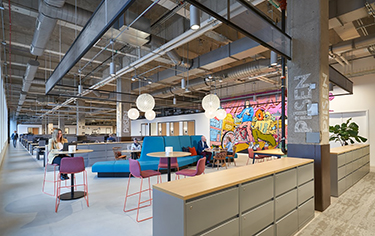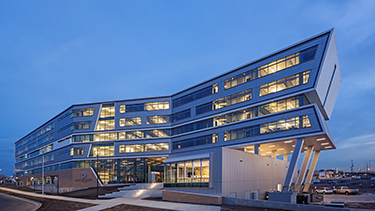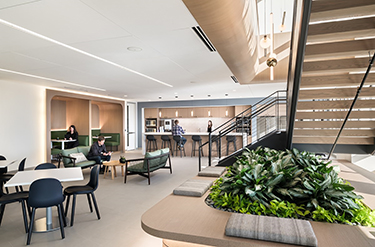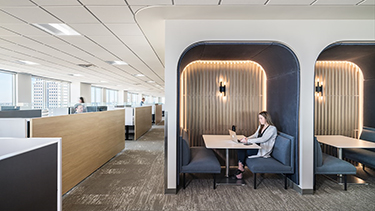|
Subscribe / Renew |
|
|
Contact Us |
|
| ► Subscribe to our Free Weekly Newsletter | |
| home | Welcome, sign in or click here to subscribe. | login |
Architecture & Engineering
| |
 |
February 24, 2022
Holistic Heroes: Lighting designers use efficiency and modeling
Stantec

MacLeod
|

Fitzgerald
|

Pederson
|
We don’t think of ourselves as superheroes. But sometimes, that’s the underlying job description for a lighting designer.
How so?
When it comes to holistic building design solutions, lighting design is often the best place to implement aggressive energy efficiency measures — it’s our chance to be the hero. Code compliance (the villain) frequently limits what the building envelope and HVAC design can offer. Lighting is where to get the most savings. Both the lighting power density and control sequencing factor into the savings.
Traditional energy codes focus on lighting power density and controls in a prescriptive manner. However, more and more jurisdictions are replacing these requirements with performance-based energy modeling simulations.
That’s why our lighting design and sustainability teams are like The Avengers of building design. (Independently, we’re strong. Together, we’re almost unstoppable.)
Our lighting team and sustainability team work together closely. We share insights gained from energy modeling best practices and use them on all projects, whether an energy model is being provided or not. Using those details for each project results in lower lighting power densities and beautiful design.
Basically, a holistic approach makes us stronger designers and results in less energy use.
In looking at a snapshot of 60-plus projects over the past five years, our lighting design team has produced designs that are on average 35% better than code-mandated performance (2015 codes or newer). These projects perform well from an energy standpoint, and many are award winners for providing lighting-design solutions that focus on occupancy comfort and spatial experience.
SCENE 1: SETTING AN EXAMPLE
Take, for example, our work for Denver Water. A recently completed renovation of its historic 35-acre campus included eight buildings. One was a new 186,000-square-foot administration building.
The complex embodies environmental stewardship at every level, applying sustainable and biophilic design principles. It received multiple LEED certifications, including LEED Platinum for the admin building. The design supports Denver Water should it choose to pursue WELL Building and Net Zero Energy certification. It’s clear that Denver Water wants to set an example of sustainability and workplace wellness.
With both LEED and WELL standards to balance, the campus lighting systems were designed for productivity, user comfort, and energy efficiency, adding to the ebb and flow of the architectural elements. The building form maximizes daylight and views. The lighting controls include perimeter and skylight daylight harvesting, occupancy sensors, local dimming, and task tuning. The admin building’s lighting load is 0.53 watts per square foot — 36% better than is required by local code and the entire campus is 39% better. Using task lights to enhance ambient lighting reduce overall usage.
SCENE 2: BIOPHILIC DESIGN
Similarly, during tenant improvement work for Delta Dental’s new 55,000-square-foot office space, our team focused on both performance and reinforcing the strong biophilic design.
The daylighting strategy was the driving force on this project. In fact, Delta Dental’s system is programmed to give it double its floor plate depth of daylight-harvesting penetration per what code minimum dictates. Welcoming, bright offices and conference rooms feature glass walls that create transparency and allow light to penetrate between spaces. Occupancy controls and manual dimming give Delta’s team the flexibility to customize its lighting experience to meet a variety of needs.
To augment the daylight, we used several lighting forms and layers to create warmth and visual interest. Higher wattage doesn’t necessarily equate to a bright-feeling space (or a comfortable space, for that matter). We worked closely with the interior design team to optimize the feeling of light in every space.
Our efforts resulted in a lighting load that is 45% better than required, yet the spaces are comfortable. The design flows seamlessly into the overall interior design aesthetic.
SCENE 3: AN EFFICIENT HQ
One of our biggest lighting design challenges came with the adaptive reuse of Chicago’s historic Post Office building. Transforming this massive 130,000-square-foot floorplate into a welcoming, modern corporate office required an incredible level of collaboration with the interior design team and creativity on the part of our lighting designers. Adaptive reuse for energy efficiency is a challenge in even the best of circumstances, but the size and layout of this project took those challenges to a new level. The huge building didn’t allow us to add daylight. So instead, we used electric light to enhance the space.
From the start, we knew the walls would be essential to our strategy. We used them to reflect light back into the space and create a sense of brightness that would make the interior spaces feel as light as the daylit perimeter. But continuous linear lighting quickly eats up an energy budget, so we also needed to be strategic about where we used it.
The design team created a concept inspired by Chicago’s local neighborhoods. Each area is defined by wall murals and furnishings, including decorative luminaires, that reflect that area of the city. Linear lighting is focused on the vibrant murals. Where there were no murals or accents, walls were finished white to reflect light back into the space.
Lighting in open office and meeting rooms was thoughtfully placed to provide the highest output on desktops. Lower levels in-between modulated the light over large areas by reducing light levels in areas without visual tasks, like hallways and circulation areas. By selecting decorative fixtures with screw-base sockets, we found LED lamps that still met the client’s strict standards.
Ultimately our efforts resulted in a lighting load of 0.38 watts per square foot, 53% better than required while illuminating the space in an exciting, energetic way that was perfect for our corporate client’s needs.
HOLISTIC HEROES
Each of these projects was approached with the performance of the whole space in mind. It was essential that the team consider the unique needs of each client to achieve the perfect balance of sustainability, wellness, and ambiance.
Doing that, we could exceed energy efficiency expectations, create the best-possible work environment, and wear our superhero capes one more time.
Lauren MacLeod is a principal in Stantec’s Seattle office; Rachel Fitzgerald is a principal and the lighting discipline lead for Stantec; and Vannessa Pederson is a senior lighting designer at Stantec.
Other Stories:
- Meet Solera: where mixed-income meets mixed-use meets family time
- Redefining offices to inspire confidence
- The benefits of implementing BIM coordination
- The evolution of hyper-local community spaces
- A new perspective on structural fire safety is here
- Reimagining the middle school experience, even before the pandemic






